Quite the challenge with the oxidation.The next step is to use niobium.
You are using an out of date browser. It may not display this or other websites correctly.
You should upgrade or use an alternative browser.
You should upgrade or use an alternative browser.
Chinese Engine Development
- Thread starter jackbh
- Start date
Hence why CMCs are more promising.Quite the challenge with the oxidation.
The info was publicly released in AVIC annual report. WS-10 used single-crystal blades when it went into production, the alloy was DZ125. WS-15 will use single-crystal blades with alloy IC10 (all "4th gen" blades are likely to use IC10 variations)I think AL-31 uses directional solidified blades.
It kind of make sense of the engine life of the older WS-10 if it uses DS blades too. Squeeze the performance and suffer the shorter creep life.
So if they now have SX casting mastered, I am wondering if that they kept developing the metallurgy with Rhenium etc and cooling & TBC/ceramic coating technology in parallel, and were able to apply in on the new versions were the reason for the re-speccing of WS-15.
Each one of them may not be much, but you lump them together against DS blades, that is some massive gain in performance and life.
DZ125 is directionally solidified blade not single crystal.The info was publicly released in AVIC annual report. WS-10 used single-crystal blades when it went into production, the alloy was DZ125. WS-15 will use single-crystal blades with alloy IC10 (all "4th gen" blades are likely to use IC10 variations)
see below paper on DZ125 creep.
IC10 is single crystal per the paper.
Seems like chemical composition for IC10 is C Co Cr Al W Mo Ta Hf B Ni.
To me seems to be comparable to western first gen SC alloy with C & B carrying over from DS alloy predecessors, and might be a DS alloy to start of with.
Compare with say composition of Ni Cr Co Mo W Ti Hf Ta Re for 2nd gen SC alloy like CMSX4.
The papers I see on IC10 kind of follows the trend on improving the castability of it with stuff like Ti etc. Generally, to improve castability, some Re helps, on top of bumping the creep temp.
Are you sure they are using IC10 on WS-15 and not a further development?
DZ125 is directionally solidified blade not single crystal.
see below paper on DZ125 creep.
IC10 is single crystal per the paper.
Seems like chemical composition for IC10 is C Co Cr Al W Mo Ta Hf B Ni.
To me seems to be comparable to western first gen SC alloy with C & B carrying over from DS alloy predecessors, and might be a DS alloy to start of with.
Compare with say composition of Ni Cr Co Mo W Ti Hf Ta Re for 2nd gen SC alloy like CMSX4.
The papers I see on IC10 kind of follows the trend on improving the castability of it with stuff like Ti etc. Generally, to improve castability, some Re helps, on top of bumping the creep temp.
Are you sure they are using IC10 on WS-15 and not a further development?
DZ125 can be directional solidified, or single crystal. IC10 are usually said to be single crystal.
My impression is a type of "superalloy" may go through different treatment processes for different purposes. But that may or may not be accurate.
Umm the problem is the carbon and the boron. It’s all good in a ds blade, in single crystal they segragate in grain boundary and has poor fatigue properties. It’s not ideal. Plus they really do need the rhenium for the enhanced properties.DZ125 can be directional solidified, or single crystal. IC10 are usually said to be single crystal.
My impression is a type of "superalloy" may go through different treatment processes for different purposes. But that may or may not be accurate.
eliminating the grain boundary in sx is all nice and being able to grow it (cast it) at scale is what counts for the first step. Just that the chem mix of that material seems more F-100 than F-119 lol
Awesome thanks man!ws-10 seems to use DD6
In 2018, "the development and application of the second-generation single crystal superalloy DD6 and its aero-engine turbine blades" won the National Technology Progress Award.
DD6 does seem to fit the bill for WS-10. Great piece of engineering dropping Re to 2% for the cost savings and bumping refractory elements to compensate. Seems very Chinese haha, go for the big chunk savings!
It looks comparable to PWA 1484 used on F-100s and vastly superior to CMSX-4. Still a way to go against F119 though. I think EJ200 uses RR3000 which is essentially CMSX-10 and its kind of in the ball park with F119, though still inferior. CMSX-10 is only 20 or 30 degrees better than CMSX-4. (I use CMSX-4 alot on the solar turbines on gas compressors, and they talked about newer ones with CMSX-10...)
DD6 should be pretty good for the larger turbofans too. CMSX-4 was good enough for Trent 800 for the 777, so with DD6 that is like a CMSX-4 plus (or CSMX-10 minus) we are in the ball park for something for C929 no? In any case, if they do use DD6 in these engines, the performance bump and mean time between overhaul definitely kicks the older Russian engines out of the park.
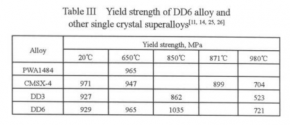
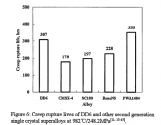
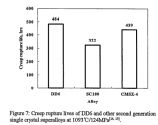
Edit: nvm I was wrongAwesome thanks man!
DD6 does seem to fit the bill for WS-10. Great piece of engineering dropping Re to 2% for the cost savings and bumping refractory elements to compensate. Seems very Chinese haha, go for the big chunk savings!
It looks comparable to PWA 1484 used on F-100s and vastly superior to CMSX-4. Still a way to go against F119 though. I think EJ200 uses RR3000 which is essentially CMSX-10 and its kind of in the ball park with F119, though still inferior. CMSX-10 is only 20 or 30 degrees better than CMSX-4. (I use CMSX-4 alot on the solar turbines on gas compressors, and they talked about newer ones with CMSX-10...)
DD6 should be pretty good for the larger turbofans too. CMSX-4 was good enough for Trent 800 for the 777, so with DD6 that is like a CMSX-4 plus (or CSMX-10 minus) we are in the ball park for something for C929 no? In any case, if they do use DD6 in these engines, the performance bump and mean time between overhaul definitely kicks the older Russian engines out of the park.
View attachment 103921View attachment 103922
View attachment 103923
Last edited:
ws-10 seems to use DD6
In 2018, "the development and application of the second-generation single crystal superalloy DD6 and its aero-engine turbine blades" won the National Technology Progress Award.
Awesome thanks man!
DD6 does seem to fit the bill for WS-10. Great piece of engineering dropping Re to 2% for the cost savings and bumping refractory elements to compensate. Seems very Chinese haha, go for the big chunk savings!
It looks comparable to PWA 1484 used on F-100s and vastly superior to CMSX-4. Still a way to go against F119 though. I think EJ200 uses RR3000 which is essentially CMSX-10 and its kind of in the ball park with F119, though still inferior. CMSX-10 is only 20 or 30 degrees better than CMSX-4. (I use CMSX-4 alot on the solar turbines on gas compressors, and they talked about newer ones with CMSX-10...)
DD6 should be pretty good for the larger turbofans too. CMSX-4 was good enough for Trent 800 for the 777, so with DD6 that is like a CMSX-4 plus (or CSMX-10 minus) we are in the ball park for something for C929 no? In any case, if they do use DD6 in these engines, the performance bump and mean time between overhaul definitely kicks the older Russian engines out of the park.
View attachment 103921View attachment 103922
View attachment 103923
outdated information.
WS-10 latest variants use third generation DD9 single crystal superalloy.
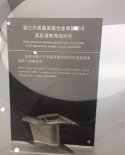
4th Generation single crystal superalloy also display during Zhuhai air show 2021.
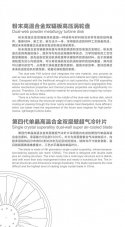
even breakthrough has done in 5th Generation single crystal superalloy. will be use in next generation engine.
